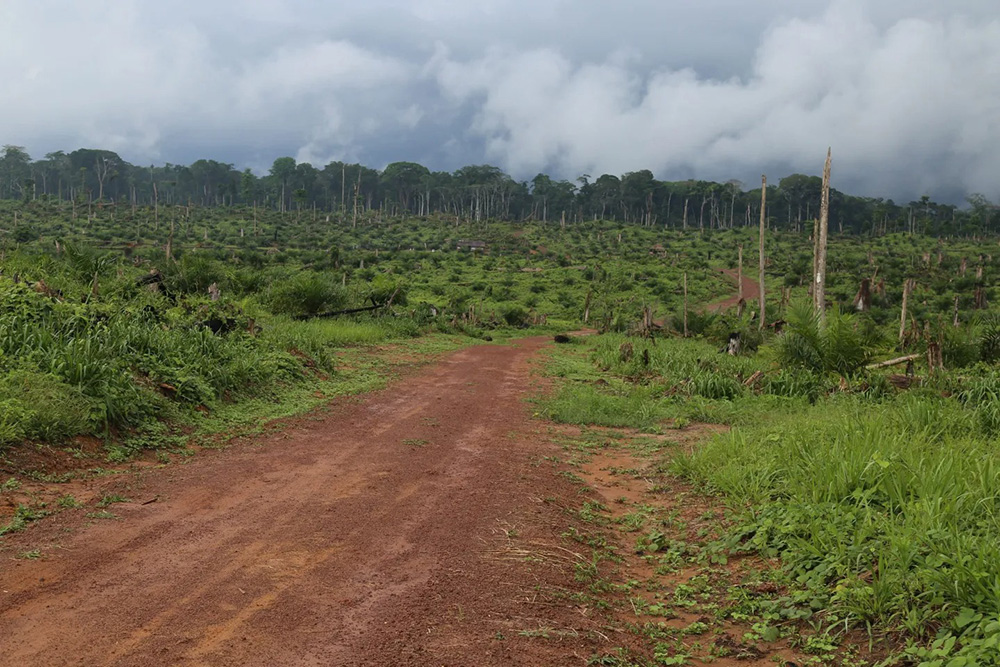
时间来到了2050年,由于降雨的消失,青尼罗河几乎干涸,而这些降雨的源头在历史上一直来自于刚果盆地雨林贡献的大气河流。萨赫尔、非洲之角和撒哈拉北部近5亿人口如今走上了迁徙之路,以远离干旱、饥荒和水资源争夺战带来的灾难性影响,而这一切归咎于数十年前人们对失控的灾难性气候变化听之任之。尽管刚果盆地重要的生态意义有据可查,然而在刚果盆地这个非洲之心、地球第二大雨林因人类活动、森林砍伐和气候变化遭到大面积破坏时,我们却在袖手旁观。事实证明,失去地球第二大肺对很多生态系统、人口甚至是整个国家来说是致命的,会影响到整个大陆甚至整个地球的安全和稳定性。
有人可能会觉得上述景象是危言耸听,或者过于遥远而不切实际。然而,科学认为,由于我们对气候变化无动于衷、视而不见,我们正加速迈向这个可能出现的未来。
我们必须尽快培养新一代的非洲科学家,以研究、记录、监测和解释形成刚果盆地重要生态系统的复杂生态过程,以及当代人类活动对盆地雨林自身存在的威胁。
25年钱,巴西在亚马逊流域发起了大规模生物大气圈研究(LBA)。该项目由巴西人主导,得到了国际社会高达1亿美元的资金支持。该项目涉及1700名参与者,其中990名都是巴西人。它颠覆了我们对亚马逊雨林及其对地球系统影响的理解。该项目最伟大的传承之一就是打造了一支巴西科学家队伍。受此影响,巴西如今是全球公认的热带雨林监测领域强国,而且在热带雨林科学方面处于领先地位。亚马逊科学专委会便源于这项动议,它涵盖280名科学家,他们在格拉斯哥第26届联合国气候变化大会(COP26)召开前夕发布了标志性的《2021亚马逊评估报告》(Amazon Assessment Report)。
虽然亚马逊备受国际捐赠者的重视,但地球第二大雨林刚果盆地在很大程度上遭到了忽视。尽管得不到足够的重视和国际捐赠者的资助,但刚果本土前不久涌现出了一批科学家。
在刚果盆地保护和可持续管理方面并非没有相关资金,例如中非森林动议(CAFI)和刚果盆地森林联盟,但这些资金并不足以支撑相关的科研费用,而这些科研对于我们理解生态系统和培养生态系统管理能力至关重要。长期数据库和研究站少之又少,即便有,这些机构始终难以按年度筹措到哪怕并不算多的资金。
得益于英国利兹大学(University of Leeds)西蒙•路易斯发起的永久植物保护区网络AFRITRON,以及包括Lopé、Epulu、Kibale和Budongo在内的几家重要工作站(尽管没有得到普遍关注,但一些有毅力的研究员坚持耕耘了几十年),我们拿到了一些证据,能够证明刚果盆地在碳汇方面的作用。确实,尽管刚果盆地只有亚马逊面积的三分之一,但它留存了近40%的碳储量,而且其森林对于气候变化的耐受度要高于亚马逊南部雨林。如今,虽然其面积较小,但代表的碳汇要大得多。
一些不怎么全面的零碎初期研究显示,由刚果盆地雨林提供的生态系统服务对非洲和全球的稳定至关重要,例如其叶片蒸发带来的冷却效应,以及飘至埃塞俄比亚高地和萨赫尔的大气河,它们产生的降水不仅补充了青尼罗河,也为埃及提供了灌溉用水。
别再犯错了:如果我们失去刚果盆地雨林,全球应对气候变化的举措将倒退15—20年。我们还将失去水源,这个由非洲绿色心脏供给的命脉,而且在未来数十年之后,其后果将由数亿气候难民来承担。
简而言之,没有了刚果盆地雨林,非洲将成为不毛之地,或至少这是根据现有不充分的证据推断出的结果。
在担任刚果盆地科学专委会特别专员(SPCB)这一新职务之后,我的任务就是敲响警钟。我们必须在科学家、捐赠者和决策者之间架设更多的桥梁。SPCB与我们的姊妹动议刚果盆地科学动议需要您的支持和投资。如果要维持全世界生态的稳定,我们必须更好地了解和保护这一关键的生态系统。这个系统是8000万人的家园,而且进一步维系着周边地区3亿非洲农民的生计。
那些研究高空拍摄卫星图片的发达国家研究员无法为我们提供有关雨林的深入了解。我们需要刚果盆地科学家实地考察,深入森林,从土著居民那里学习,全面地掌握植物、动物、人、气候、水文和地质之间复杂的互动。
亚马逊科学专委会给了我们很大的启发,我们期待向其学习并与之建立紧密的关系。在SCPB参与第三十届联合国气候大会之时,我们的首个评估报告将准备就绪。被誉为雨林气候大会的COP30将于2025年在贝伦市举行。
有鉴于地球之肺受到了生存威胁,我们必须行动起来,发起持久的变革。(财富中文网)
本文作者李•怀特(Lee White)教授曾担任加蓬共和国水务、森林、海洋和环境部长,是新任命的刚果盆地科学专委会特别专员。
译者:冯丰
审校:夏林
时间来到了2050年,由于降雨的消失,青尼罗河几乎干涸,而这些降雨的源头在历史上一直来自于刚果盆地雨林贡献的大气河流。萨赫尔、非洲之角和撒哈拉北部近5亿人口如今走上了迁徙之路,以远离干旱、饥荒和水资源争夺战带来的灾难性影响,而这一切归咎于数十年前人们对失控的灾难性气候变化听之任之。尽管刚果盆地重要的生态意义有据可查,然而在刚果盆地这个非洲之心、地球第二大雨林因人类活动、森林砍伐和气候变化遭到大面积破坏时,我们却在袖手旁观。事实证明,失去地球第二大肺对很多生态系统、人口甚至是整个国家来说是致命的,会影响到整个大陆甚至整个地球的安全和稳定性。
有人可能会觉得上述景象是危言耸听,或者过于遥远而不切实际。然而,科学认为,由于我们对气候变化无动于衷、视而不见,我们正加速迈向这个可能出现的未来。
我们必须尽快培养新一代的非洲科学家,以研究、记录、监测和解释形成刚果盆地重要生态系统的复杂生态过程,以及当代人类活动对盆地雨林自身存在的威胁。
25年钱,巴西在亚马逊流域发起了大规模生物大气圈研究(LBA)。该项目由巴西人主导,得到了国际社会高达1亿美元的资金支持。该项目涉及1700名参与者,其中990名都是巴西人。它颠覆了我们对亚马逊雨林及其对地球系统影响的理解。该项目最伟大的传承之一就是打造了一支巴西科学家队伍。受此影响,巴西如今是全球公认的热带雨林监测领域强国,而且在热带雨林科学方面处于领先地位。亚马逊科学专委会便源于这项动议,它涵盖280名科学家,他们在格拉斯哥第26届联合国气候变化大会(COP26)召开前夕发布了标志性的《2021亚马逊评估报告》(Amazon Assessment Report)。
虽然亚马逊备受国际捐赠者的重视,但地球第二大雨林刚果盆地在很大程度上遭到了忽视。尽管得不到足够的重视和国际捐赠者的资助,但刚果本土前不久涌现出了一批科学家。
在刚果盆地保护和可持续管理方面并非没有相关资金,例如中非森林动议(CAFI)和刚果盆地森林联盟,但这些资金并不足以支撑相关的科研费用,而这些科研对于我们理解生态系统和培养生态系统管理能力至关重要。长期数据库和研究站少之又少,即便有,这些机构始终难以按年度筹措到哪怕并不算多的资金。
得益于英国利兹大学(University of Leeds)西蒙•路易斯发起的永久植物保护区网络AFRITRON,以及包括Lopé、Epulu、Kibale和Budongo在内的几家重要工作站(尽管没有得到普遍关注,但一些有毅力的研究员坚持耕耘了几十年),我们拿到了一些证据,能够证明刚果盆地在碳汇方面的作用。确实,尽管刚果盆地只有亚马逊面积的三分之一,但它留存了近40%的碳储量,而且其森林对于气候变化的耐受度要高于亚马逊南部雨林。如今,虽然其面积较小,但代表的碳汇要大得多。
一些不怎么全面的零碎初期研究显示,由刚果盆地雨林提供的生态系统服务对非洲和全球的稳定至关重要,例如其叶片蒸发带来的冷却效应,以及飘至埃塞俄比亚高地和萨赫尔的大气河,它们产生的降水不仅补充了青尼罗河,也为埃及提供了灌溉用水。
别再犯错了:如果我们失去刚果盆地雨林,全球应对气候变化的举措将倒退15—20年。我们还将失去水源,这个由非洲绿色心脏供给的命脉,而且在未来数十年之后,其后果将由数亿气候难民来承担。
简而言之,没有了刚果盆地雨林,非洲将成为不毛之地,或至少这是根据现有不充分的证据推断出的结果。
在担任刚果盆地科学专委会特别专员(SPCB)这一新职务之后,我的任务就是敲响警钟。我们必须在科学家、捐赠者和决策者之间架设更多的桥梁。SPCB与我们的姊妹动议刚果盆地科学动议需要您的支持和投资。如果要维持全世界生态的稳定,我们必须更好地了解和保护这一关键的生态系统。这个系统是8000万人的家园,而且进一步维系着周边地区3亿非洲农民的生计。
那些研究高空拍摄卫星图片的发达国家研究员无法为我们提供有关雨林的深入了解。我们需要刚果盆地科学家实地考察,深入森林,从土著居民那里学习,全面地掌握植物、动物、人、气候、水文和地质之间复杂的互动。
亚马逊科学专委会给了我们很大的启发,我们期待向其学习并与之建立紧密的关系。在SCPB参与第三十届联合国气候大会之时,我们的首个评估报告将准备就绪。被誉为雨林气候大会的COP30将于2025年在贝伦市举行。
有鉴于地球之肺受到了生存威胁,我们必须行动起来,发起持久的变革。(财富中文网)
本文作者李•怀特(Lee White)教授曾担任加蓬共和国水务、森林、海洋和环境部长,是新任命的刚果盆地科学专委会特别专员。
译者:冯丰
审校:夏林
It is the year 2050. The Blue Nile has almost run dry, starved of the rains at its source that were historically sustained by atmospheric rivers flowing from the Congo Basin rainforests. Nearly half a billion people across the Sahel, the Horn of Africa, and north of the Sahara are now on the move, fleeing the devastating impact of droughts, famine, and water wars, the result of allowing unmitigated climate change to get out of control decades earlier. Despite the evidence of their critical ecological importance, we stood by while the Congo Basin, the heart of Africa, the Earth’s second great rainforest, was decimated by human activity, deforestation, and climate change. Losing the earth’s second lung proved fatal for many ecosystems, human populations, and even entire nations—shattering the security and stability of the continent and indeed the whole planet.
This may sound too alarmist or far-fetched to be true—but science suggests that we are hurtling toward this alternate future because of our inactivity and negligence in the face of climate change.
We must urgently develop a generation of African scientists able to study, document, monitor, and explain the complex ecological processes that have structured the vital Congo Basin ecosystem, as well as the threats posed by modern human activities to its very existence.
Twenty-five years ago, Brazil launched the Large-Scale Biosphere-Atmosphere experiment in Amazonia (LBA). The program was led by Brazilians and supported by the international community to the tune of $100 million. Involving 1,700 participants, 990 of whom were Brazilians, it revolutionized our understanding of the Amazon rainforest and its role in the Earth system. One of its greatest legacies was the creation of a cadre of Brazilian scientists. As a result, Brazil is now widely acknowledged as the world’s leading nation in tropical forest monitoring and is at the forefront of rainforest science. The Science Panel of the Amazon grew out of this initiative and includes 280 scientists, who published the landmark 2021 Amazon Assessment Report in the lead up to COP 26 in Glasgow.
Whilst the Amazon has attracted huge attention from international donors, the Congo Basin, Earth’s second great rainforest, has been largely neglected. Only now is a cadre of indigenous scientists emerging, despite the context of insufficient attention and funding from international donors.
The funds that do exist for the conservation and sustainable management of the Congo Basin, such as the Central African Forest Initiative (CAFI) or the Congo Basin Forest Partnership, are insufficient to support the science that is critical to our understanding and ability to manage the ecosystem. Very few long-term data bases and research stations exist—and those that do struggle permanently to raise even relatively modest funding on an annual basis.
Thanks to AFRITRON, a network of permanent botanical plots initiated by Professor Simon Lewis at the University of Leeds in the U.K., and a few key long-term sites such as Lopé, Epulu, Kibale, and Budongo, where stubborn researchers have plugged away over decades despite the general lack of interest, we do have some indications of the importance of the Congo Basin as a carbon sink. Indeed, while it is only one-third the area of the Amazon, the Congo Basin contains roughly 40% the carbon stock and its forests are proving more resilient to climate change than the southern Amazon. Today, they represent a much larger carbon sink, despite their smaller size.
Incomplete, fragmented, or preliminary studies suggest that the ecosystem services provided by the Congo basin forests, such as the cooling effect of transpiration from their leaves and the atmospheric rivers that flow to the Ethiopian Highlands and the Sahel, generating the rainfall that fills the Blue Nile and irrigates Egypt, are critical to African and global stability.
Make no mistake: If we lose the Congo Basin forests, the global fight against climate change will be set back by 15 to 20 years. We would also lose the water, the lifeblood of Africa that is pumped out of its green heart—and the consequences will be counted in hundreds of millions of climate refugees in the coming decades.
Put simply, Africa is not viable without the Congo Basin forests—or at least that is the indication of the scant evidence that exists.
In my new role as the Special Envoy of the Science Panel for the Congo Basin (SPCB), it is my duty to sound the alarm. We must build more bridges between scientists, donors, and policy makers. The SPCB, along with our sister initiative, the Science Initiative for the Congo Basin, need your support and investment. If our world is to remain ecologically stable, we have to better understand and preserve this critical ecosystem, which is home to 80 million people and supports life for a further 300 million rural Africans in surrounding regions.
The depth of understanding we need will not come from developed nation researchers studying satellite images taken from afar. We need Congo Basin scientists, on the ground, in the forest, learning from indigenous people and piecing together the complex interactions between plants, animals, people, climate, hydrology, and geology.
We are inspired by and looking to learn from and develop strong links with the Science Panel for the Amazon. By the time the SCPB touches down at COP30, the rainforest COP, which will be held in Belem in 2025, our first assessment report will be ready.
With the world’s lungs under existential threat, we must mobilize to create lasting change.
Professor Lee White is a former Minister of Water, Forests, Sea and Environment of the Gabonese Republic and the newly appointed Special Envoy of the Science Panel for the Congo Basin.






